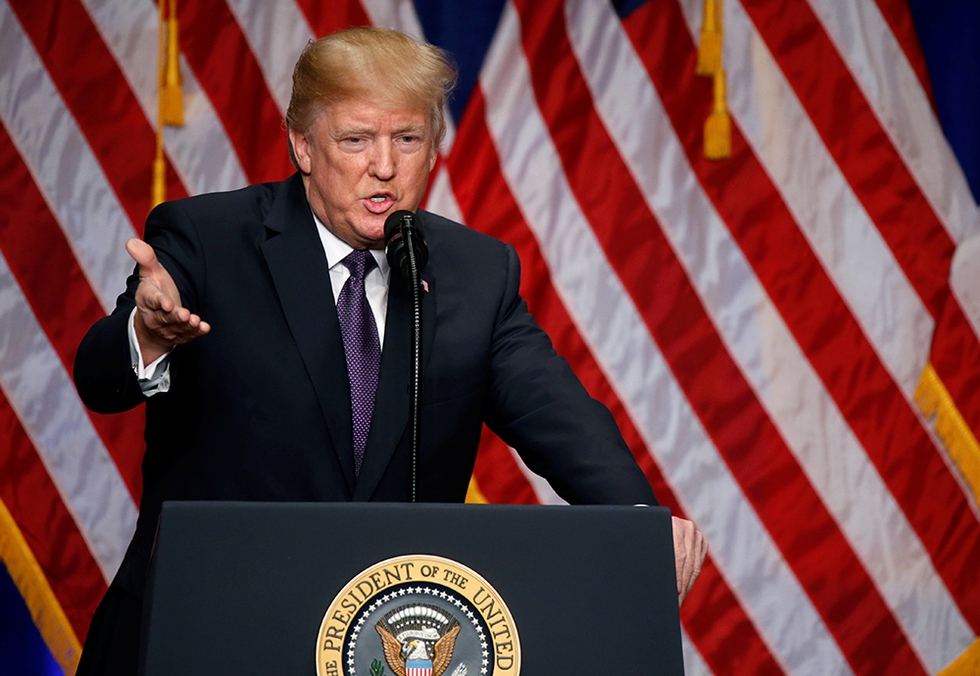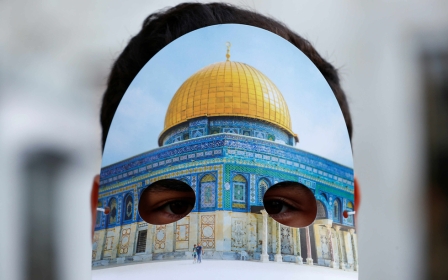ANALYSIS: No rest for 'jihadists' in Trump's Middle East blueprint

NEW YORK, United States – President Donald Trump unveiled his national security strategy on Monday, signalling plans to turn the screws tighter on Iran while boosting Middle Eastern security with warmer ties between Israel and its Arab neighbours.
At the global level, the 68-page strategy blueprint unveiled by Trump formalised much that he has already spoken and tweeted about – reiterating his “America First” campaign maxim with economic and military gains that outpace China, Russia and other competitors.
But plenty in the document spotlighted the Middle East, with friendly overtures to such US allies as Saudi Arabia and Israel, and a continuation of the anti-Iran rhetoric that has marked a departure from the Obama-era nuclear deal.
Middle East Eye read the document, listened to Trump’s speech and spoke with administration officials and analysts about what the Middle East can expect to see from this White House team over the next three years.
1. No rest for ‘jihadists’
The loudest round of applause during Trump’s speech came as he trumpeted the sustained battlefield setbacks for the Islamic State (IS) group, which has seen its self-declared caliphate shrinking across Iraq and Syria.
“We have dealt ISIS one devastating defeat after another,” Trump told a crowd of some 650 bigwigs at the Ronald Reagan Building in downtown Washington, using an alternate acronym for IS.
“The coalition to defeat ISIS has now recaptured almost 100 percent of the land once held by these terrorists ... we're now chasing them wherever they flee, and we will not let them into the United States.”
Former President Barack Obama’s administration had dropped the phrase “Islamic extremism” for fear of offending Muslim allies. The terms “jihad” and “jihadist” came back with a vengeance on Monday, with 27 appearances in Trump’s strategy document.
"Jihadist terrorist organisations present the most dangerous terrorist threat to the nation," Trump said.
"America, alongside our allies and partners, is fighting a long war against these fanatics who advance a totalitarian vision for a global Islamist caliphate that justifies murder and slavery, promotes repression, and seeks to undermine the American way of life. Jihadist terrorists use virtual and physical networks around the world to radicalise isolated individuals, exploit vulnerable populations, and inspire and direct plots."
This was hardly a surprise – Trump has repeatedly railed against Muslims, ordered a travel ban targeting people from six Muslim-majority countries and shared anti-Muslim videos posted on Twitter by a far-right British party leader.
In policy terms, the document calls for tighter security at US borders, tougher vetting of people coming to the US and an uncompromising military response to IS, al-Qaeda and others who plan and stage attacks against the US.
Criticism came soon after Trump had stepped off a podium that was decorated with star-spangled banners, led by Hina Shamsi, from the American Civil Liberties Union, which campaigns for human rights.
“From the Muslim ban to the dramatic surge in lethal strikes in majority-Muslim countries to deportation, surveillance, and vetting policies targeting vulnerable immigrants and minorities, Trump is doubling down on bigotry and injustice,” said Shamsi.
2. Israel, Palestine and the Saudi romance
Trump’s speech came in the wake of his widely condemned decision to recognise Jerusalem as Israel’s capital – a move that was viewed worldwide as loading the dice in Israel’s favour ahead of any peace deal with Palestinians.
It also came on the same day that the US used its veto power at the United Nations Security Council to block a draft resolution voted for by the other 14 members of the council to condemn Washington's move.
If it was not already clear that Trump was relegating the creation of an independent Palestinian state to the diplomatic backburner, his new strategy document reinforced the idea that landless Palestinians are at the back of the line.
“For generations the conflict between Israel and the Palestinians has been understood as the prime irritant preventing peace and prosperity in the region,” the document says.
“Today, the threats from jihadist terrorist organisations and the threat from Iran are creating the realisation that Israel is not the cause of the region’s problems. States have increasingly found common interests with Israel in confronting common threats.”
For many analysts, Trump is pushing for greater cooperation between Israel and Gulf petro-monarchies to counter Iranian expansionism and to nudge the Palestinians towards settling a peace deal with Israel.
“There’s no surprise that the US sees Saudi and Israel as equal pillars to the implementation of its regional agenda, and Trump wants to use the peace process as a glue to officially bind them together,” Sigurd Neubauer, an analyst for the Gulf International Forum, a think tank, told MEE.
“Whether or not he is able to do that is the million dollar question.”
3. The regional rogue: Iran
Trump’s security strategy is, of course, more focused on threats than friends – meaning the Middle Eastern country at the heart of the policy outline was Iran, which gets a dozen citations in the document.
In his speech, Trump blasted the “incomprehensibly bad deal” that Obama struck with Iran and other world powers to delay Tehran’s alleged nuke-building scheme, and praised the sanctions he recently slapped on the Islamic Revolutionary Guard Corps.
His document lists Iran’s “malign activities” in the region as it expands its influence in Iraq and Syria, using proxy groups, such as Hezbollah, which has fought in support of Syrian President Bashar al-Assad's government.
“Iran, the world’s leading state sponsor of terrorism, has taken advantage of instability to expand its influence through partners and proxies, weapon proliferation, and funding,” the document says.
“It continues to develop more capable ballistic missiles and intelligence capabilities, and it undertakes malicious cyber activities.”
But, according to Richard Haass, president of the Council of Foreign Relations, a New York-based think tank, and a former White House official in several administrations, Trump’s policy proposal also hits a roadblock.
“It wasn’t clear to me what the administration plans to do, whether it’s Yemen, Iraq, Lebanon or Syria or anywhere else vis-a-vis Iran,” Haass told MEE.
“This document doesn’t provide anything in the way of policy guidance and the administration obviously is in something of a quandary where it wants to push back against Iran in the region, and I would say for good reason, but it’s not clear what the tools are.”
Middle East Eye propose une couverture et une analyse indépendantes et incomparables du Moyen-Orient, de l’Afrique du Nord et d’autres régions du monde. Pour en savoir plus sur la reprise de ce contenu et les frais qui s’appliquent, veuillez remplir ce formulaire [en anglais]. Pour en savoir plus sur MEE, cliquez ici [en anglais].




